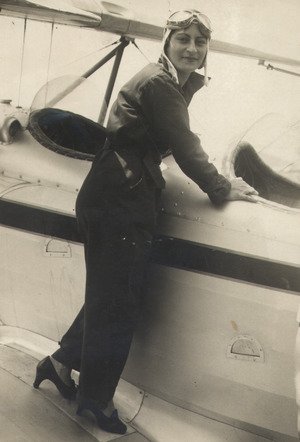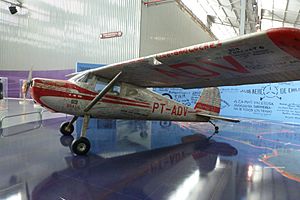Ada Rogato facts for kids
Quick facts for kids
Ada Rogato
|
|
|---|---|

In 1936.
|
|
| Born | 22 December 1910 São Paulo, Brazil
|
| Died | 15 November 1986 (aged 65) São Paulo, Brazil
|
| Nationality | Brazilian |
| Other names | Ada Leda Rogato |
| Occupation | aviator |
| Years active | 1935-1986 |
| Known for | First woman glider pilot and first woman paratrooper of Brazil. Numerous flight records. |
Ada Rogato (born December 22, 1910 – died November 15, 1986) was an amazing Brazilian pilot. She was a true pioneer, meaning she was one of the first women to do many important things in aviation. Ada broke five records during her career.
She was the first woman in South America to get a glider pilot's license. She was also the first Brazilian woman to become a certified paratrooper. Ada even set a world record for the longest solo flight! She was the first person to fly across all three Americas (North, Central, and South). Plus, she held the Brazilian record for the most parachute jumps. Ada was also Brazil's first woman agricultural pilot. She flew special planes to spray crops and help protect them from pests.
Contents
Early Life and Learning to Fly
Ada Leda Rogato was born in São Paulo, Brazil, on December 22, 1910. Her parents had moved to Brazil from Italy. Like many girls at the time, she had basic schooling. She also learned painting and played the piano.
From a young age, Ada dreamed of flying. But when her parents separated, she had to help her mother. She did housework and sold embroideries to earn money. Ada saved her earnings carefully. In 1935, she had enough money to take flying lessons. She joined the Flying Club of São Paulo. There, she earned her glider pilot's license. This made her the first Brazilian and first South American woman glider pilot!
In 1936, Ada continued her training. She passed her tests to become an airplane pilot. She flew many different types of planes. These included American-made planes and Brazilian ones like the Muniz M-7. Ada was the third licensed airplane pilot in Brazil. She followed Teresa De Marzo and Anésia Pinheiro Machado. Ada also worked as a test pilot for new light aircraft built in Brazil. She even started flying in air shows. To earn a living, she learned typing and joined the civil service.
Amazing Career in the Skies

In 1940, Ada Rogato started working as a secretary at the Biological Institute. The next year, she took a skydiving course. She earned the first Brazilian paratrooper certification! After this, the Aeronautics Ministry asked her to help train others.
During World War II, Ada volunteered for special missions. She patrolled the coast of São Paulo. For her service, she became the first woman to receive the title of Pilot in Honoris Causa from the Brazilian Air Force. In 1942, Ada did a very brave night parachute jump. She was the only woman in a group of six. They jumped from a Focke-Wulf plane into the bay off Rio de Janeiro. The president, Getúlio Vargas, watched the jump.
Flying for Farmers
When Ada returned to the Biological Institute, she was asked to become an agricultural pilot in 1948. She had already flown over 1,200 hours! The Institute hired her to spray insecticide. This helped fight tiny beetles that were destroying Brazil's coffee crops. She worked as a crop duster. She wore special protective gear while spraying.
Ada had her only serious accident during this time. Her spraying equipment broke, causing her plane to crash. She was in the hospital for a month. After she recovered, Ada went back to crop-dusting.
Record-Breaking Flights
In 1950, Ada took a break from her job. She flew her own plane to airshows in Argentina, Chile, and Paraguay. In Chile, she became the first woman to skydive in the country. People cheered when she landed with both Brazilian and Chilean flags! The Chilean government honored her. She also flew her small Paulistinha plane across the Andes mountains. For this, she received an aeronautical merit medal. She was also given a Cessna 140 plane.
In 1951, Ada set a world record for the longest solo flight. She flew 51,064 miles over six months! Her journey started in Tierra del Fuego and ended in Anchorage, Alaska. She flew south from Rio de Janeiro to Uruguay and Argentina. Then she crossed the Andes. She flew along the west coast of South America, Central America, and North America to reach Anchorage. From there, she flew even further north to Fort Yukon at the Arctic Circle.
Ada then flew back south to Seattle. She continued to Washington, D.C., and then to Montreal and Ottawa in Canada. After that, she flew through the Caribbean. She visited Cuba, Haiti, the Dominican Republic, Puerto Rico, Trinidad, Venezuela, and all three Guyanas. Finally, she returned to Brazil. This amazing trip was called a "good-neighbor tour." She met with the first ladies of the 17 countries she visited.
More Firsts and Challenges
In 1952, Ada Rogato became the first civilian pilot to land a small plane at El Alto International Airport in La Paz, Bolivia. At that time, it was the highest airport in the world! In 1956, she flew to every capital city in Brazil. She became the first pilot to fly over the Amazon rainforest.
In 1960, Ada made another first. She was the first woman to arrive at Ushuaia, in Tierra del Fuego. This was the southernmost city in the world back then. What's even more amazing is that all of Ada's flights were solo. She flew in small planes (85 horsepower or less). These planes didn't have fancy instruments or even a radio! She held the Brazilian record for parachute jumps, with 105 jumps.
Ada retired from her government job in 1980. She had become the chief of the Sports and Tourism section. But she kept flying until just four years before she passed away. People say she only stopped flying because she couldn't break any more records without a more powerful plane. From 1980 to 1986, Ada was the director of the Museum of Aeronautics and Space of São Paulo. She also served as president of the Santos Dumont Foundation.
Death and Legacy
Ada Rogato passed away on November 15, 1986, in São Paulo. Her body was displayed at the Museum of Aeronautics. She was buried in the Santana Cemetery in São Paulo. A special "squadron of smoke" flew a tribute for her.
Ada was the first woman to receive the National Commendation of Aeronautical Merit. She also became the first woman Wing Commander in the Brazilian Air Force. The government of Chile honored her in 1951. In 1952, she received special wings from the Bolivian Air Force for her flight to La Paz. Ada was also honored by the Colombian Air Force. In 1954, she received The Paul Tissandier Diploma of Merits in Aviation from a French aviation group.
There is a street in Ribeirão Preto named after her. A town square in Lapa also bears her name. In 2000, the Brazilian Post Office issued a stamp to celebrate her flight over the Andes. In 2011, a Brazilian writer named Lucita Briza wrote a book about Ada's life. It was called Ada—Mulher, pioneira, aviadora (Ada—Woman, pioneer, aviator). Ada's medals and her Cessna plane have been on display at the TAM Museum in São Carlos since 2012.
See Also
- Teresa De Marzo
- Anésia Pinheiro Machado

